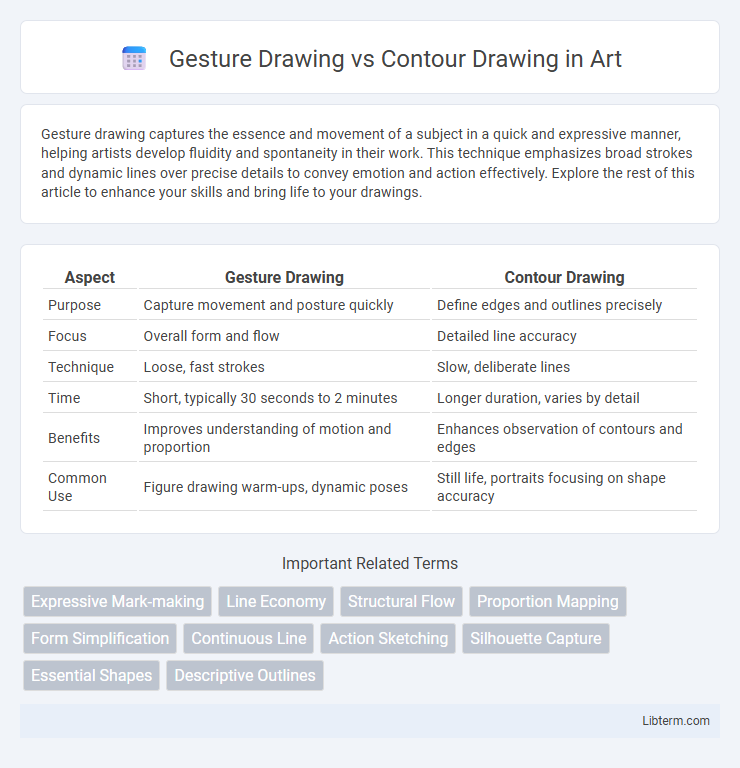Gesture drawing captures the essence and movement of a subject in a quick and expressive manner, helping artists develop fluidity and spontaneity in their work. This technique emphasizes broad strokes and dynamic lines over precise details to convey emotion and action effectively. Explore the rest of this article to enhance your skills and bring life to your drawings.
Table of Comparison
| Aspect | Gesture Drawing | Contour Drawing |
|---|---|---|
| Purpose | Capture movement and posture quickly | Define edges and outlines precisely |
| Focus | Overall form and flow | Detailed line accuracy |
| Technique | Loose, fast strokes | Slow, deliberate lines |
| Time | Short, typically 30 seconds to 2 minutes | Longer duration, varies by detail |
| Benefits | Improves understanding of motion and proportion | Enhances observation of contours and edges |
| Common Use | Figure drawing warm-ups, dynamic poses | Still life, portraits focusing on shape accuracy |
Understanding Gesture Drawing
Gesture drawing captures the essence and movement of a subject with quick, fluid strokes to convey motion and posture rather than detailed anatomy. It emphasizes capturing action and energy within short time frames, typically ranging from 10 to 60 seconds per sketch. This method helps artists improve their ability to observe dynamic poses and develop a sense of rhythm and flow in figure drawing.
What is Contour Drawing?
Contour drawing emphasizes capturing the precise outlines and edges of a subject, focusing on detailed observation rather than quick gesture or movement. This technique involves slow, deliberate strokes to define the structure and form, enhancing hand-eye coordination and improving the artist's ability to render accurate shapes. Unlike gesture drawing, contour drawing prioritizes line quality and spatial relationships over dynamic motion or proportions.
Key Differences Between Gesture and Contour Drawing
Gesture drawing captures the overall movement and flow of a subject, emphasizing dynamic poses and energy within quick, loose strokes to convey action and form. Contour drawing focuses on the precise outlines and edges of a subject, prioritizing accurate shapes, proportions, and intricate details with deliberate, continuous lines. Gesture drawing serves to understand motion and posture, while contour drawing enhances observation skills and spatial accuracy in representation.
Purpose and Applications of Gesture Drawing
Gesture drawing emphasizes capturing the movement, flow, and basic form of a subject, making it essential for improving an artist's ability to depict dynamic poses quickly and expressively. This technique is widely applied in figure drawing, animation, and life drawing sessions to develop a keen sense of proportion, rhythm, and body language. Gesture drawing serves as a foundational exercise to enhance observational skills and convey energy and motion in artworks.
Purpose and Applications of Contour Drawing
Contour drawing emphasizes capturing the precise edges and intricate details of a subject to enhance observational skills and hand-eye coordination. This technique is widely used in fine arts education to improve accuracy and control while fostering a deeper understanding of form and structure. It is applied in disciplines such as illustration, portraiture, and technical drawing where detailed representation is essential.
Techniques Involved in Gesture Drawing
Gesture drawing employs rapid, fluid strokes to capture the essence and movement of a subject, emphasizing speed and expressiveness over detail. Techniques include loose wrist motion, continuous lines, and quick observational sketches that prioritize proportions and dynamic poses. This practice enhances an artist's ability to depict energy and form, making it crucial for developing lifelike figure drawings.
Techniques Involved in Contour Drawing
Contour drawing techniques emphasize capturing the outline and essential details of a subject through continuous, deliberate lines without lifting the pencil, enhancing hand-eye coordination and observation skills. Blind contour drawing involves sketching the subject's contours without looking at the paper, improving accuracy and focus on form rather than the drawing itself. Cross-contour lines follow the three-dimensional form of the subject, adding depth and volume to the drawing by emphasizing surface changes and structure.
Common Mistakes in Gesture and Contour Drawing
Common mistakes in gesture drawing include overworking lines, resulting in stiff poses rather than capturing fluid motion, and focusing too much on details instead of the overall energy and flow. In contour drawing, a frequent error is lifting the pen from the paper too often, disrupting the continuous line that defines the subject's shape and textures. Both methods require maintaining confident, intentional strokes to improve accuracy and expressiveness.
When to Use Gesture vs Contour Drawing
Gesture drawing is ideal for capturing the dynamic movement and overall flow of a subject, especially during warm-up exercises or quick studies where energy and motion are prioritized. Contour drawing suits detailed observation, enhancing fine motor control and accuracy when focusing on the edges and intricate outlines of objects. Artists often use gesture drawing in initial stages to establish form and rhythm, transitioning to contour drawing to refine shapes and develop precision.
Tips for Improving Both Drawing Styles
Gesture drawing benefits from quick, fluid motions that capture the essence and movement of the subject; practicing timed sketches and focusing on overall shapes rather than details enhances this skill. Contour drawing improves through deliberate, slow observation, encouraging artists to draw the outline and important internal details without looking at the paper, which sharpens hand-eye coordination and attention to form. Combining both techniques by alternating between fast gesture studies and precise contour lines leads to stronger, more dynamic figure drawings.
Gesture Drawing Infographic

 libterm.com
libterm.com